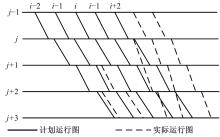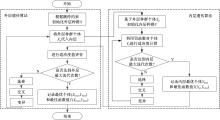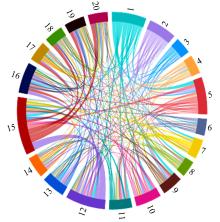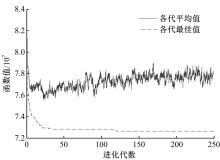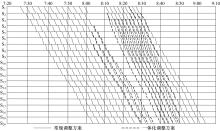Journal of Jilin University(Engineering and Technology Edition) ›› 2021, Vol. 51 ›› Issue (5): 1664-1672.doi: 10.13229/j.cnki.jdxbgxb20200467
Optimization of urban rail transit operation adjustment based on multiple strategies under delay
Zuo-an HU1,2( ),Yi-ming XIA1,Jia CAI1,Feng XUE1,2(
),Yi-ming XIA1,Jia CAI1,Feng XUE1,2( )
)
- 1.School of Transportation and Logistics,Southwest Jiaotong University,Chengdu 611756,China
2.National Engineering Laboratory for Integrated Transportation Big Data Application Technology,Southwest Jiaotong University,Chengdu 611756,China
CLC Number:
- U231.92
| 1 | 2019年度城市轨道交通运营情况[J]. 城市轨道交通, 2020(6): 37-41. |
| 2 | Jamili A, Aghaee M P. Robust stop-skipping patterns in urban railway operations under traffic alteration situation[J]. Transportation Research Part C, 2015, 61: 63-74. |
| 3 | 刘祥喜. 突发大客流城市轨道交通列车停站方案优化研究[D]. 北京: 北京交通大学土木建筑与工程学院, 2012. |
| Liu Xiang-xi. Study on stop-schedule plan optimization for urban rail transit under outburst mass passenger flow[D]. Beijing: School of Civil and Architectural Engineering, Beijing Jiaotong University, 2012. | |
| 4 | Suh W, Chon K S, Rhee S M. Effect of skip-stop policy on a Korean subway system[J]. Transportation Research Record, 2002, 1793(1): 33-39. |
| 5 | Niu H M, Zhou X S, Gao R H. Train scheduling for minimizing passenger waiting time with time-dependent demand and skip-stop patterns: nonlinear integer programming models with linear constraints[J]. Transportation Research Part B, 2015, 76: 117-135. |
| 6 | 郑锂, 宋瑞, 何世伟, 等. 城市轨道交通跨站停车方案优化模型及算法[J]. 铁道学报, 2009, 31(6): 1-8. |
| Zheng Li, Song Rui, He Shi-wei, et al. Optimization model and algorithm of skip-stop strategy for urban rail transit[J]. Journal of the China Railway Society, 2009, 31(6): 1-8. | |
| 7 | Cao Z C, Yuan Z Z, Li D W. Estimation method for a skip-stop operation strategy for urban rail transit in China[J]. Journal of Modern Transportation, 2014, 22(3): 174-182. |
| 8 | 王婵婵, 陈菁菁. 城市轨道交通列车延误时多线换乘站跳停方案研究[J]. 城市轨道交通研究, 2014, 17(12): 69-72. |
| Wang Chan-chan, Chen Jing-jing. On the skip-stop schemes at rail transit transfer station in case of train delay[J]. Urban Mass Transit, 2014, 17(12): 69-72. | |
| 9 | 何占元, 阴佳腾, 王明主. 基于线性规划模型的城轨列车运行图调整策略[J]. 太原科技大学学报, 2019(40): 296-301. |
| He Zhan-yuan, Yin Jia-teng, Wang Ming-zhu. Urban rail train diagram adjustment strategy based on linear programming model[J]. Journal of Taiyuan University of Science and Technology, 2019(40): 296-301. | |
| 10 | 阴佳腾. 基于近似动态规划的城轨列车运行一体化调整方法研究[D]. 北京: 北京交通大学电子信息工程学院, 2018. |
| Yin Jia-teng. Intergrated metro train rescheduling optimization based on approximate dynamic programming[D]. Beijing: School of Electronic Information Engineering, Beijing Jiaotong University, 2018. | |
| 11 | 乔珂, 赵鹏, 禹丹丹. 基于乘客等待时间的城市轨道交通列车运行调整模型[J]. 北京交通大学学报, 2014, 38(6): 32-38. |
| Qiao Ke, Zhao Peng, Yu Dan-dan. Train regulation model of urban rail transit based on passenger waiting time[J]. Journal of Beijing Jiaotong University(对应英文??), 2014, 38(6): 32-38. | |
| 12 | Xu X, Li K, Yang L. Rescheduling subway trains by a discrete event model considering service balance performance[J]. Applied Mathematical Modelling, 2016, 40: 1446-1466. |
| 13 | Yang X, Chen A, Ning B, et al. Bi-objective programming approach for solving the metro timetable optimization problem with dwell time uncertainty[J]. Transportation Research Part E Logistics & Transportation Review, 2017, 97: 22-37. |
| 14 | 孙锋, 王殿海, 胡宏宇, 等. 基于出行时间分析的公交跳站运行方案优化[J]. 吉林大学学报: 工学版, 2012, 42(): 179-183. |
| Sun Feng, Wang Dian-hai, Hu Hong-yu, et al. Optimizing skip-stop operation of bus transit based on analysis of travel time[J]. Journal of Jilin University (Engineering and Technology Edition), 2012, 42(Sup.1): 179-183. | |
| 15 | 赵航, 安实, 金广君, 等. 考虑车辆运输能力限制的公交换乘优化[J]. 吉林大学学报: 工学版, 2012, 42(3): 606-611. |
| Zhao Hang, An Shi, Jin Guang-jun, et al. Optimization of transit transfer with vehicle capacity constrains[J]. Journal of Jilin University(Engineering and Technology Edition), 2012, 42(3): 606-611. | |
| 16 | Vuchic V R. Urban Transit: Operation, Planning and Economics[M]. New Jersey: John Wiley & Sons, USA, 2004. |
| [1] | Cai-hua ZHU,Xiao-li SUN,Yan LI. Forecast of urban public bicycle traffic demand by station classification [J]. Journal of Jilin University(Engineering and Technology Edition), 2021, 51(2): 531-540. |
| [2] | Qing-yu LUO,Wan-li TIAN,Hong-fei JIA. Location and capacity model of electric vehicle charging station considering commuting demand [J]. Journal of Jilin University(Engineering and Technology Edition), 2019, 49(5): 1471-1477. |
| [3] | CAO Qian, LI Jun, LIU Yu, QU Da-wei. Construction of driving cycle based on Markov chain for passenger car in Changchun City [J]. Journal of Jilin University(Engineering and Technology Edition), 2018, 48(5): 1366-1373. |
| [4] | SUN Bao-feng, GAO Kun, SHEN Xiu-xiu, LIANG Ting. Location model of gas station for network expansion based on capacity balance and variable coverage radius [J]. 吉林大学学报(工学版), 2018, 48(3): 704-711. |
| [5] | XU Liang,CHENG Guo-zhu. Setting minimum vehicle speed limit on freeway based on speed scattering and economic speed [J]. 吉林大学学报(工学版), 2010, 40(03): 661-0665. |
|
||
